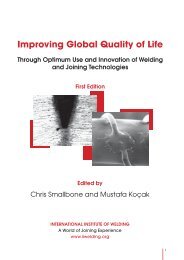(LTT) Filler Wires
(LTT) Filler Wires
(LTT) Filler Wires
You also want an ePaper? Increase the reach of your titles
YUMPU automatically turns print PDFs into web optimized ePapers that Google loves.
The lower transformation temperature of filler weld<br />
metal results in considerably lower residual stresses as<br />
shown clearly in Figure 5. Moreover, <strong>LTT</strong> filler wires<br />
may introduce significant longitudinal compressive<br />
residual stresses within the fusion zone [20]. Similarly,<br />
numerous recent works conducted to investigate the<br />
effect of M S temperature of the filler wire on the<br />
residual stresses developed within the weld region of<br />
high strength steels [1, 8, 15, 17, 18, 20, 21] also<br />
indicate that the amount of distortion developed may be<br />
reduced and even compressive residual stresses can be<br />
induced with the use of these newly developed <strong>LTT</strong><br />
filler materials.<br />
It is thus clear that weld metals with intermediate C<br />
contents (i.e. sufficient weldability) has a better chance<br />
to benefit from martensite expansion. Thus, it can be<br />
said that alloyed weld metals (low M S temperature)<br />
with an intermediate carbon content (decrease of the<br />
stresses due to martensite expansion and good<br />
weldability) yield low residual stresses and distortion.<br />
The welded structures with lower residual stresses also<br />
display better properties such as fatigue life [5-7, 9, 10]<br />
and cold cracking [22] with some degradation in<br />
fracture toughness [23]. However, as pointed out<br />
earlier, the fracture toughness of the recently developed<br />
<strong>LTT</strong> filler alloy has been found satisfactory [12].<br />
Futhermore, several workers [11, 17] have studied the<br />
effect of the martensitic transformation expansion of<br />
weld metals on welding distortion and reported that the<br />
welds produced using <strong>LTT</strong> filler wires exhibit lower<br />
distortion compared to those experienced using<br />
conventional filler wires.<br />
Figure 3. Microstructures of two-layer welds in S690 Q steel<br />
produced with a <strong>LTT</strong> (10% Ni-10% Cr) filler: a) macro-section,<br />
b) transition between root and final pass, c) light coloured<br />
segregation of Ni (retained austenite) between martensite in final<br />
pass, and d) martensitic structure in root pass [15]<br />
Figure 4. Variation of residual stress and strain developed during<br />
cooling using conventional and <strong>LTT</strong> filler wires: a) strain and b)<br />
stress [10]<br />
4. Fatigue properties<br />
High tensile residual stresses forming in high strength<br />
steel welds accelerate the fatigue crack propagation and<br />
reduce fatigue life of the weldment [7]. Another reason<br />
for reduced fatigue strength of weldments is the stress<br />
concentration [24]. The basic approach for improved<br />
fatigue strength in high strength steel welds is to avoid<br />
the joining in highly stressed areas. When this is not<br />
possible then the following measures are usually taken<br />
[7, 25]:<br />
reducing stress concentration by improved<br />
structural design,<br />
improving weld quality (e.g. geometry or<br />
introduction of compressive residual stresses)<br />
by post-weld treatment of critical welds, such<br />
as grinding of weld toe, hammer peening and<br />
shot blasting,<br />
replacing welded connections by mechanical<br />
fastening methods, for instance bolted<br />
connections.<br />
However, all of these methods increase the production<br />
time and cost. Another way of reducing tensile residual<br />
stresses or even introducing compressive residual<br />
stresses is the use of newly developed low<br />
transformation temperature (<strong>LTT</strong>) filler materials as<br />
earlier mentioned.<br />
762
















